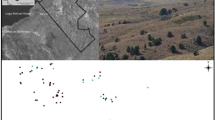Summary
The purpose of this study was to simultaneously measure pollen dispersal distance and actual pollen-mediated gene-flow distance in a wind-pollinated herb, Plantago lanceolata. The pollen dispersal distribution, measured as pollen deposition in a wind tunnel, is leptokurtic, as expected from previous studies of wind-pollinated plants. Gene-flow, measured as seeds produced on rows of male-sterile inflorescences in the wind tunnel, is non-leptokurtic, peaking at an intermediate distance. The difference between the two distributions results from the tendency of the pollen grains to cluster. These pollen clusters are the units of gene dispersal, with clusters of intermediate and large size contributing disproportionately to gene-flow. Since many wind-pollinated species show pollen clustering (see text), the common assumption for wind-pollinated plants that gene-flow is leptokurtic requires re-examination. Gene-flow was also measured in an artifical outdoor population of male-steriles, containing a single pollen source plant in the center of the array. The gene flow distribution is significantly platykurtic, and has the same general properties outdoors, where wind speed and turbulence are uncontrolled, as it does in the wind tunnel. I estimated genetic neighborhood size based on my measure of gene-flow in the outdoor population. The estimate shows that populations of Plantago lanceolata will vary in effective number from a few tens of plants to more than five hundred plants, depending on the density of the population in question. Thus, the measured pollen-mediated gene-flow distribution and population density will interact to produce effective population sizes ranging from those in which there is no random genetic drift to those in which random genetic drift plays an important role in determining gene frequencies within and among populations. Despite the platykurtosis in the distribution, pollen-mediated gene dispersal distances are still quite limited, and considerable within and among-population genetic differentiation is to be expected in this species.
Similar content being viewed by others
References
Andersen ST (1970) Pollen dispersal in Draved Forest. Danmark Geol. Undersoegelse II:96, 7
Bateman AJ (1947) Contamination of seed crops. III. Relation with isolation distance. Heredity 1:303–336
Beattie AJ (1979) Neighborhood size in Viola. Evolution 33:1226–1229
Colwell RN (1951) The use of radioactive isotopes in determining spore distribution patterns. Amer J Bot 38:511–523
Fisher RA (1925) Statistical methods for research workers. Oliver & Boyd, Edinburgh
Griffiths DJ (1950) The liability of seed crops of perrenial rye grass (Lolium perenne) to contamination by wind borne pollen. J Agric Sci 40:19–38
Handel SN (1976) Restricted pollen flow of two woodland hervs determined by neutron-activation analysis. Nature (London) 260:422–423
May RM, Endler JA, McMurtrie RE (1975) Gene frequency clines in the presence of selection opposed by gene flow. Amer Nat 109:659–676
Price MV, Waser NM (1982) Experimental studies of pollen carryover: Hummingbirds and Ipomopsis aggregata. Oecologia (Berlin) 54:353–358
Rai KN, Jain SK (1982) Population biology of Avena. IX. Gene flow and neighborhood size in relation to microgeographic variation in Avena barbata. Oecologia (Berlin) 53:399–405
Raynor GS, Ogden EC, Hayes JV (1972) Despersion and deposition of timothy pollen from experimental sources. Agric Meteorol 9:347–366
Schaal BA (1980) Measurement of gene-flow in Lupinus texensis. Nature 284:450–451
Schemske DW, Fenster C (1983) Pollen grain interactions in a neotropical Costus: effects of clump size and competitors. In: DL Mulcahy, E Ottaviano (eds). Pollen: Biology and implications for plant breeding. Elsevier, New York, pp 228–253
Slatkin M (1973) Gene flow and selection in a cline. Genetics 75:733–756
Snedecor GW, Cochran WG (1961) Statistical methods, 6th ed. Iowa State Univ. Press, Ames
Stelleman P (1982) Ph.D. Thesis. Univ. of Amsterdam, Amsterdam, The Netherlands
Thomson JD, Plowright RC (1980) Pollen carryover, nectar rewards, and pollinator behavior with special reference to Diervilla lonicera. Oecologia (Berlin) 46:68–74
Wright S (1946) Isolation by distance under diverse systems of mating. Genetics 34:39–59
Wright S (1969) Evolution and the genetics of populations, Vol. II. The theory of gene frequencies. Univ. of Chicago Press, Chicago
Wright S (1977) Evolution and the genetics of populations, Vol. III. Experimental results and evolutionary deductions. Univ. of Chicago Press, Chicago
Wu L, Antonovics J (1976) Experimental ecological genetics in Plantago. I. Induction of roots and shoots on leaves for large scale vegetative propagation and metal tolerance testing in Plantago lanceolata. New Phytol 75:277–282
Author information
Authors and Affiliations
Rights and permissions
About this article
Cite this article
Tonsor, S.J. Leptokurtic pollen-flow, non-leptokurtic gene-flow in a wind-pollinated herb, Plantago lanceolata L.. Oecologia 67, 442–446 (1985). https://doi.org/10.1007/BF00384953
Received:
Issue Date:
DOI: https://doi.org/10.1007/BF00384953




